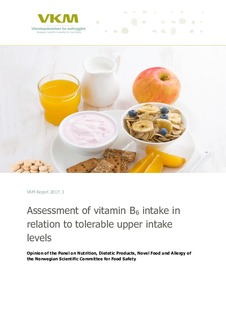| dc.description.abstract | The Norwegian Scientific Committee for Food Safety (Vitenskapskomiteen for mattrygghet, VKM) has, at the request of the Norwegian Food Safety Authority (Mattilsynet; NFSA), assessed the intake of vitamin B6 (pyridoxine) in the Norwegian population in relation to tolerable upper intake levels (ULs). The existing maximum limit for vitamin B6 in food supplements is 4.2 mg/day. VKM has also conducted scenario calculations to illustrate the consequences of amending the maximum limitto 2, 6, 8, 10, 20 or 25 mg/day.
Vitamin B6 is water soluble and comprises six compounds with vitamin B6 activity; pyridoxine (PN, an alcohol), pyridoxal (PL, an aldehyde) and pyridoxamine (PM, the amine) and their corresponding phosphates; pyridoxine 5’-phosphate (PNP), pyridoxal 5’ -phosphate (PLP) and pyridoaxamin 5’ –phosphate (PMP). These six forms of vitamin B6 are all present in food in addition to the glycosylated form, pyridoxine-5’-β-δ-glucoside (PNG), in some plants. In food supplements the most common vitamin B6 form is pyridoxine hydrochloride. Eighty to ninety percent of vitamin B6 in the body is found in muscles and estimated body stores in adults amount to about 170 mg with a half-life of 25-33 days. Vitamin B6 deficiency is mostly seen in combination with deficiency of other B vitamins. Symptoms of vitamin B6 deficiency are anaemia and neurological abnormalities (EFSA, 2016).
Intakes of vitamin B6 from the diet alone have not been reported to cause adverse effects. Sensory neuropathy has been reported to be the most sensitive adverse health effect of vitamin B6 supplementation. VKM proposes to adopt the tolerable upper intake level (UL) set by the Scientific Committee for Food (SCF) in 2000 at 25 mg/day for vitamin B6, which was based on a lowest observed adverse effect level (LOAEL) of 100 mg/day found in one randomised controlled trial. VKM recognises that there are no well-designed dose-response studies of long-term use available. However, for adults, no adverse effects have been reported at doses with vitamin B6 up to 25 mg/day.
Dietary calculations have been performed for mean intakes and in various percentiles (P5, P25, P50, P75 and P95) in children (2-, 4- and 9-year-olds), adolescents (13-year-olds) and in adults.
To illustrate the consequences of amending the maximum limit for vitamin B6 in food supplements to 2, 6, 8, 10, 20 or 25 mg/day in the different age groups, VKM has used the scenarios with P95 from food and added the alternative amounts of supplements. VKM has compared these scenarios with the tolerable upper intake levels set by the Scientific Committee for Food in 2000 for adults, adolescents and children. In these scenarios, the 2- and 4-year-old children will exceed the tolerable upper intake level with use of 6 mg/day or higher vitamin B6 in supplements. The 9-year-old children will exceed the tolerable upper intake level with supplemental use of 10 mg/day. The 13-year-old adolescents will exceed the tolerable upper intake level with 20 mg/day of vitamin B6 in supplements. Adults will
VKM Report 2017: 3 7
exceed the tolerable upper intake level with use of 25 mg/day of vitamin B6/pyridoxine in supplements. | en |
